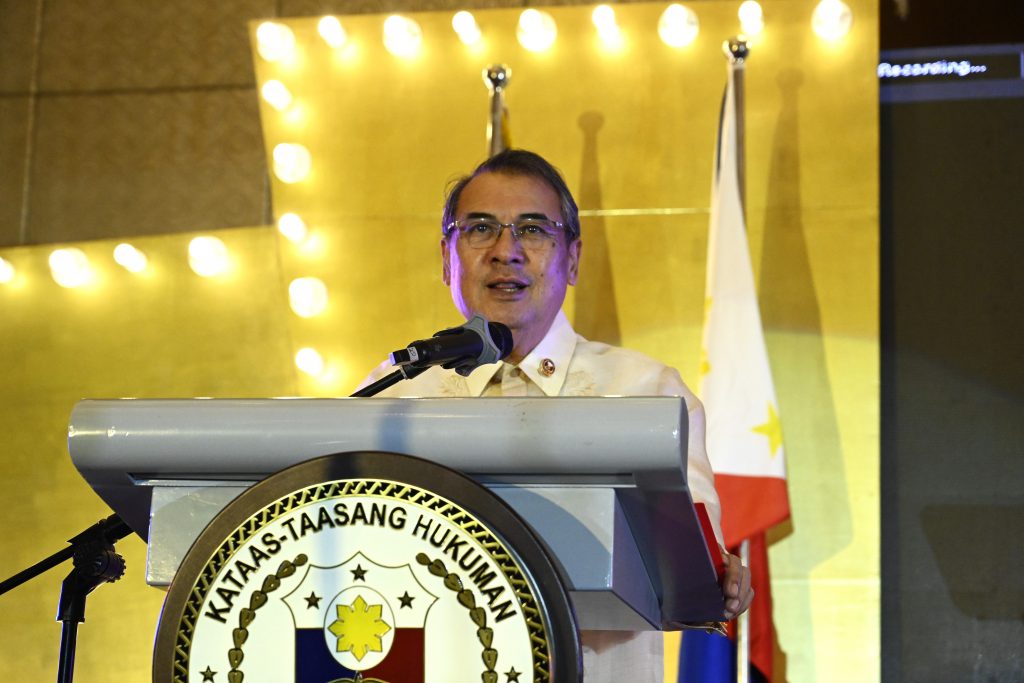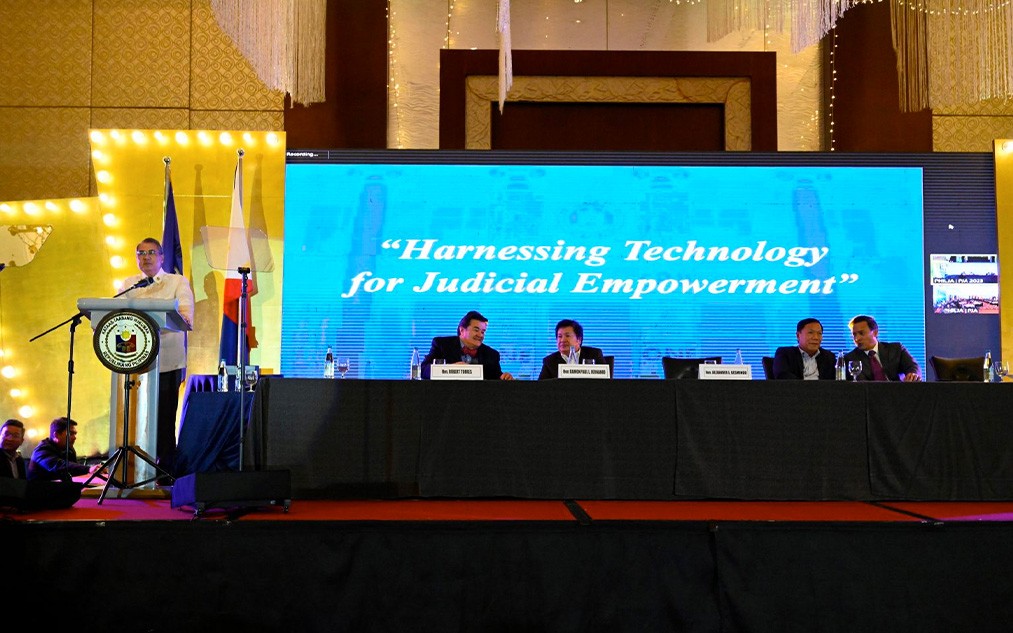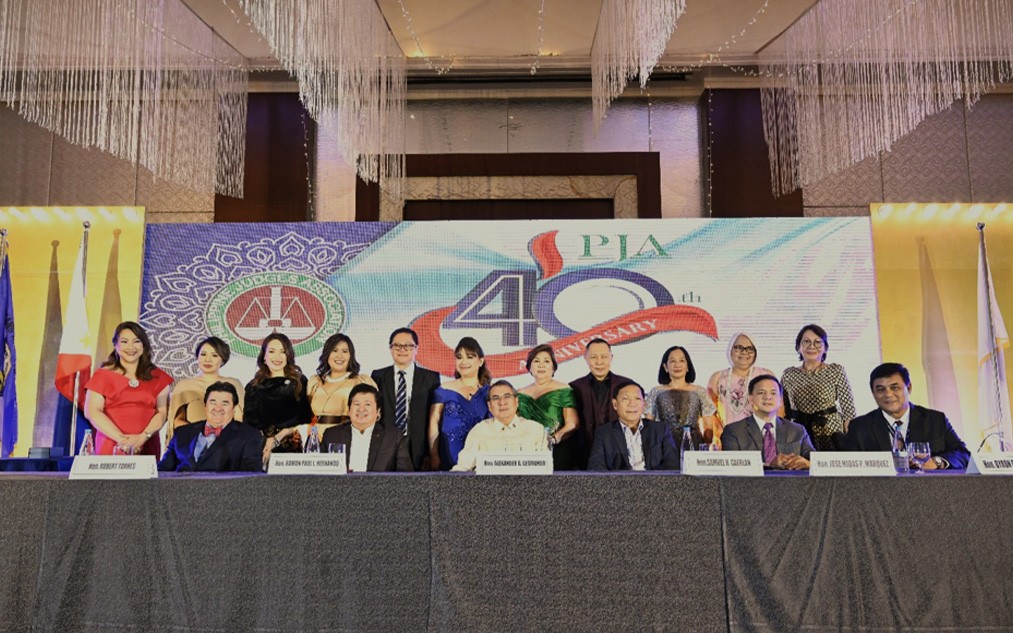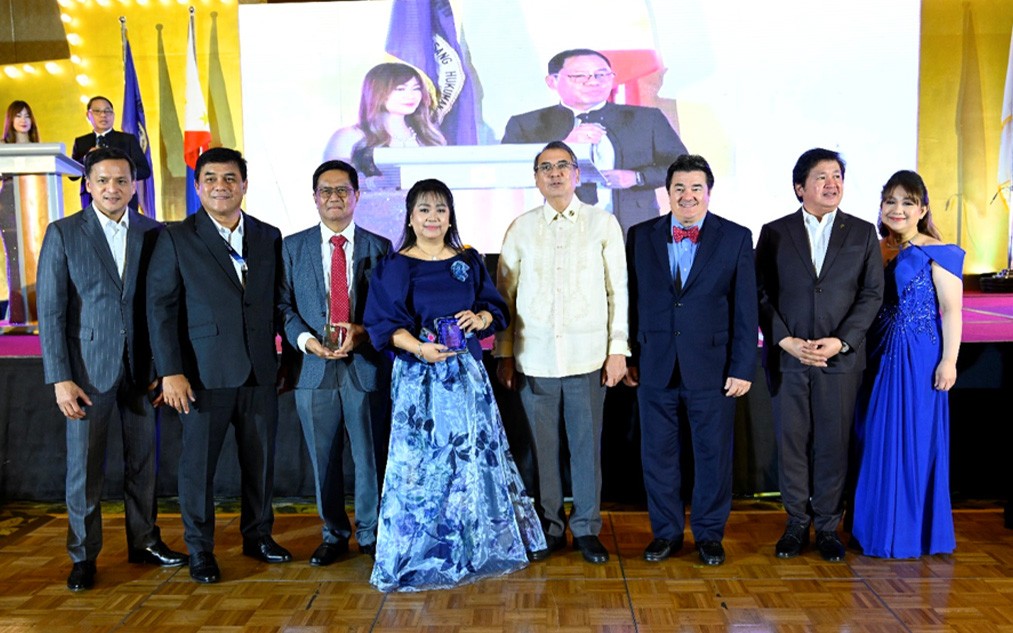Chief Justice Gesmundo Tells Judges to Maintain Momentum on Judicial Reforms
October 25, 2023

Chief Justice Alexander G. Gesmundo delivers the Inspirational Message at the President’s Night of the Philippine Judges Association (PJA) National Convention and Seminar at the EDSA Shangri-La Hotel, Mandaluyong City. (Courtesy of the SC Public Information Office)
Chief Justice Alexander G. Gesmundo has urged all trial court judges to reaffirm their commitment to support the Supreme Court’s Strategic Plan for Judicial Innovations 2022-2027 (SPJI) to maintain its momentum, as he recognized the “synchronized, well-coordinated, and dedicated efforts of the entire Judiciary” in implementing the Court’s reform initiatives.
Speaking at the Philippine Judges Association (PJA) National Convention held at the EDSA Shangri-La Hotel on October 24, 2023, Chief Justice Gesmundo called on the need to build on the momentum of reform that now prevails in the Judiciary, reminding the Judges that to strengthen their commitment to achieve more meaningful and lasting reforms to leave behind an enduring legacy to all stakeholders in the judicial system through the Court’s SPJI.
Capitalizing on the event’s theme Harnessing Technology for Judicial Empowerment, he called on the Judges to harness technology in the performance of their adjudicative and administrative duties to empower themselves.
The Chief Justice reiterated his call for all judges to always stay abreast of the innovations the Court is undertaking and to invest more knowledge in technology and skills to complement them.
“Maximize the opportunity presented by occasions like this convention to strengthen collaboration and reaffirm your association’s resolve to help realize the vision we all share: an empowered judiciary that delivers, in real time, the justice that our people deserve,” he said.
Chief Justice Gesmundo acknowledged the contribution of judges in continuing to invest their time, effort, and creativity in helping the Court achieve the objectives of the Court’s SPJI. “I know many of you are also working hard to become more technology-savvy, adopting the new tools the Court has provided in doing your day-to-day tasks, and influencing others to do the same,” the Chief expressed in gratitude.
The Chief said that the digital transformation as envisioned in the SPJI hinges on three pillars: 60% people, 20% process, and 20% technology, adding that the same proportions apply in terms of the benefits the Court hopes to bring about from this transformation. “We want to upgrade our technologies. We want to transform our processes. But the preponderant motivation in this entire pursuit remains people, in the sense of empowering both those dispensing and those seeking justice.”
The Court’s blueprint for action on judicial reforms, the SPJI, launched last year, provides a roadmap for the Judiciary in embracing technology in introducing reforms.
Chief Justice Gesmundo took the occasion to look back and share what had been accomplished since.
Among these was the adoption and deployment in lower courts of Philippine Judiciary 365, a modern workplace collaboration solution providing courts with the facility to electronically receive pleadings and other court submissions securely, hear and decide cases via videoconferencing, generate real-time transcripts of stenographic notes, and organize court calendars, among others.
Of relevance to the occasion was the establishment of the Philippine Judiciary Online Learning Platform, which optimizes alternative ways of training judges and judiciary personnel by providing distance learning through online tools and resources spearheaded by the Philippine Judicial Academy (PHILJA) with the goal of upgrading the skillsets of judges and court personnel. This goes hand in hand with the launch of the updated and digitized Benchbook for Philippine Trial Courts, containing the updated pertinent laws, treaties, rules, regulations, jurisprudence, and the latest issuances of the Court which would greatly facilitate judicial proceedings by providing an easy-access reference to aid judges in their research when crafting rulings and carrying out their tasks.
The Chief Justice also shared the completion of the formulation of the Judiciary Enterprise ICT Governance Framework. Also, the development of a much-improved eCourt version 2.0 software for a unified, comprehensive, and intelligent case management system. This will include six key features: eFiling, ePayment, eRaffle, eService, Intelligent Case Monitoring and Tracking, and eRollo.
Furthermore, he also cited the rollout of the Judiciary Electronic Payment System, which is now the required mode of payment, with certain exceptions and preferences, for the payment of legal fees and other court collections in all first- and second-level courts. Thus far, it has streamlined the process of assessing and paying court fees while also increasing transparency, accountability, and accessibility.
The Chief Justice was joined by Associate Justices Ramon Paul L. Hernando, Samuel H. Gaerlan, and Jose Midas P. Marquez.
Also present was Chief Justice of Guam, Robert J. Torres, Jr., who incidentally was conferred with the first PJA President’s Award for his invaluable support for PJA’s programs and initiatives.
The PJA is headed by its President, Byron G. San Pedro; Executive Vice President, Divina Gracia L. Pelino; Senior Vice President, Acerey C. Pacheco; Vice Presidents Gener M. Gito, Maria Paz R. Reyes-Yson, Caridad Villegas Galvez, Ma. Teresa E. De Guzman-Alvarez, Pablo C. Formaran III, Marivic A. Trabajo-Daray, Mia Joy C. Oallares-Cawed, Secretary General, Elisa R. Sarmiento-Flores; Treasurer, Cynara Hannah L. Cayton; Auditor, Mary Jane B. Dacara-Buenaventura; Public Relations Officer, Pia Cristina B. Bersamin-Embuscado; Business Manager, Tarcelo A. Sabarre, Jr. (Courtesy of the SC Public Information Office)

Chief Justice Alexander G. Gesmundo commends the Philippine Judges Association (PJA)’s theme “Harnessing Technology for Judicial Empowerment” as Guam Chief Justice Robert J. Torres, Jr., and Associate Justices Ramon Paul L. Hernando, Samuel H. Gaerlan, and Jose Midas P. Marquez listen intently. (Courtesy of the SC Public Information Office)

(Seated, from left) Guam Chief Justice Robert J. Torres, Jr., Associate Justice Ramon Paul L. Hernando, Chief Justice Alexander G. Gesmundo, Associate Justice Samuel H. Gaerlan, Assoiate Justice Jose Midas P. Marquez and Philippine Judges Association (PJA) President Judge Byron G. San Pedro are joined by the rest of the officers of the Philippine Judges Association (PJA): Secretary General, Elisa R. Sarmiento-Flores; Public Relations Officer, Pia Cristina B. Bersamin-Embuscado; Treasurer, Cynara Hannah L. Cayton; Auditor, Mary Jane B. Dacara-Buenaventura; Vice President (VP) Gener M. Gito; EVP Divina Gracia L.Pelino; VP Maria Paz R. Reyes-Yson; Business Manager, Tarcelo A. Sabarre, Jr.; VP Caridad Villegas Galvez; VP Marivic A. Trabajo-Daray; VP Mia Joy C. Oallares-Cawed. (Courtesy of the SC Public Information Office)

Chief Justice Alexander G. Gesmundo poses for posterity with (from left) Associate Justice Jose Midas Marquez, Philippine Judges Association (PJA) President Judge Byron G. San Pedro, Judge Danilo S. Cruz, Judge Racquelen Abary Vasquez, Guam Chief Justice Robert J. Torres, Jr., Associate Justice Ramon Paul L. Hernando, and Divina Gracia L.Pelino. (Courtesy of the SC Public Information Office)












